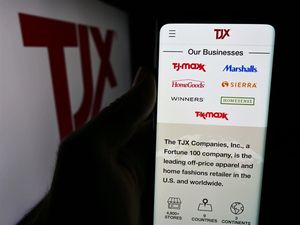
November 20, 2025 – The tech and semiconductor sectors, once seemingly unstoppable engines of growth, are currently navigating a turbulent period marked by significant stock downturns and heightened market volatility. As of November 2025, major indices like the Nasdaq Composite and the Philadelphia SE Semiconductor Index (SOX) have seen notable declines from recent highs, signaling a broad re-evaluation by investors. This recent pullback, despite robust underlying demand for Artificial Intelligence (AI) technologies, underscores a complex interplay of macroeconomic pressures, geopolitical shifts, and growing concerns over market valuations.
This market correction is more than just a momentary blip; it reflects a deeper investor apprehension regarding the sustainability of the rapid growth seen in these sectors, particularly within the burgeoning AI landscape. For investors and tech enthusiasts alike, understanding the multifaceted causes and potential implications of this downturn is crucial for navigating what could be a defining period for the global technology economy.
Unpacking the Market's Retreat: Valuations, Rates, and Geopolitics Collide
The current downturn in tech and semiconductor stocks is the culmination of several powerful forces. On November 20, 2025, Wall Street's main indexes notably lost ground, with the Nasdaq Composite falling 1.44% and the S&P 500 experiencing a 0.95% decline. The Philadelphia SE Semiconductor Index (SOX) was particularly hard hit, dropping a significant 3.35% on the same day, reflecting intense pressure on chipmakers. This came even as some industry titans, like Nvidia (NASDAQ: NVDA), saw an initial post-earnings surge quickly dissipate, turning negative with a 2.21% drop, highlighting investor skepticism about even strong results.
A primary driver of this caution is the pervasive concern over potential overvaluation, with many analysts drawing parallels to the dot-com bubble. A November 2025 Bank of America Global Fund Manager Survey revealed that a striking 45% of asset allocators identified an "AI bubble" as the biggest tail risk, up sharply from 33% just the previous month. The S&P 500's Cyclically Adjusted Price-to-Earnings (CAPE) ratio stood at approximately 36.7 in October 2025, nearly double its historical average, further fueling these valuation anxieties. Companies like Nvidia, despite its strong performance, saw its forward P/E ratio reach around 50x in late 2024, raising questions about the sustainability of such premiums.
Adding to the pressure are persistent inflationary concerns and the ripple effects of interest rate policies. While the Federal Reserve's first rate cut in September 2025 provided a brief uplift, subsequent jobs data in November 2025 clouded the outlook for further cuts, impacting market sentiment. Higher interest rates make future earnings less valuable, disproportionately affecting growth-oriented tech stocks that rely heavily on projected long-term profits. Historically, a 100-basis-point increase in the Fed funds rate has correlated with a 1% to 3% fall in R&D spending at public companies, hinting at potential long-term impacts on innovation.
Geopolitical tensions, particularly between the US and China, are also profoundly reshaping the semiconductor industry. Export controls on advanced semiconductor technologies are compelling companies to pursue costly reshoring and nearshoring strategies. For example, Taiwan Semiconductor Manufacturing Company (NYSE: TSM) is reportedly considering a 10% price increase for advanced wafers, with 4nm chip production costs in its Arizona facility being roughly 30% higher than in Taiwan. Nvidia (NASDAQ: NVDA) has also raised prices on its AI GPUs due to increased manufacturing expenses and new US tariffs, ultimately translating into higher costs for the end consumer and impacting profit margins across the supply chain.
Navigating the Tech Tides: Impact on Industry Giants and Agile Startups
The current market recalibration presents a mixed bag of challenges and opportunities for the diverse ecosystem of AI companies, established tech giants, and nascent startups. While the broader market shows signs of a downturn, the underlying demand for AI remains robust, with the global AI chip market alone projected to exceed $150 billion in 2025.
For the tech giants, often referred to as the "Magnificent Seven," strong financial positions offer a degree of resilience. Companies like Apple (NASDAQ: AAPL), Microsoft (NASDAQ: MSFT), Alphabet (NASDAQ: GOOGL), Nvidia (NASDAQ: NVDA), and Meta Platforms (NASDAQ: META) collectively reported exceptional Q3 2025 results, beating analyst EPS estimates by an average of 11.2% and achieving 18.6% year-over-year revenue growth. These companies are making substantial capital expenditures (CapEx) for AI infrastructure, with Big Tech CapEx estimates for 2025 increasing to over $405 billion, representing 62% year-over-year growth. This continued heavy investment allows them to maintain their lead in AI R&D and infrastructure, potentially widening the competitive gap with smaller, less capitalized players.
However, even these behemoths are not immune to investor scrutiny. Despite strong earnings, Nvidia's stock, for instance, turned negative on November 20, 2025, and was nearly 9% down from its October peak, reflecting concerns over AI monetization and circular spending. Similarly, Lam Research (NASDAQ: LRCX), a key semiconductor equipment manufacturer, experienced a 2.86% decline on November 18, 2025, and a 10.01% loss over the prior week, caught in the broader macroeconomic uncertainties affecting the sector. This indicates that while their operational performance remains strong, their stretched valuations are being challenged by a more cautious market.
The funding landscape for startups, particularly in AI and deep tech, is becoming significantly tighter in 2025. Investors are growing more selective, with reports indicating that only 12% of global funding reaches early-stage startups. This environment demands robust preparation, clear market fit, and adaptable strategies from new ventures. Startups face increased competition for funding, intense "talent wars" for skilled AI professionals, rising operating costs due to inflation, and difficulties in setting realistic valuations. This could lead to a consolidation phase, where well-funded startups with clear paths to profitability or those acquired by larger tech companies will thrive, while others may struggle to secure the necessary resources for growth and innovation.
Broader Implications: Innovation, Employment, and the Specter of Recession
The recent downturn in tech and semiconductor stocks carries wider significance, impacting the broader economic landscape, innovation trajectories, and even consumer costs. The concentration of market value in technology stocks creates systemic vulnerabilities, where negative "wealth effects" from equity market corrections could amplify economic slowdowns beyond financial markets, particularly for higher-income households.
In terms of innovation, while large tech companies continue to pour billions into AI R&D and infrastructure, funding challenges for startups could stifle the emergence of groundbreaking technologies from smaller, agile players. This could lead to an innovation bottleneck, where the pace of disruption slows down as capital becomes scarcer for high-risk, high-reward ventures. However, overall IT spending, driven by AI and digital transformation initiatives, is still projected to grow in 2025, indicating that the drive for technological advancement remains strong, albeit perhaps more concentrated within established firms.
The employment picture in the tech sector presents a nuanced view. While the sector is projected to see employment growth at about twice the rate of overall employment over the next decade, startups continue to struggle to find and retain qualified talent, especially in specialized AI and deep tech roles. Widespread layoffs in the tech sector, observed throughout 2024, have slowed but remain a concern, adding to broader economic uncertainty. A softer labor market outside the tech sector, coupled with persistent inflation, could further dampen economic activity and consumer spending.
For consumer technology, the geopolitical fragmentation of supply chains and reshoring efforts in the semiconductor industry are likely to lead to higher production costs. These increased costs are often passed on to consumers, potentially affecting prices for a wide range of electronics, from smartphones and laptops to automobiles and smart home devices. This could impact consumer purchasing power and slow the adoption of new technologies, creating a ripple effect across the economy. The current market sentiment, particularly the "AI bubble" fears, draws strong parallels to the dot-com bubble of the late 1990s, raising questions about whether the industry is repeating past mistakes or merely experiencing a healthy correction.
The Road Ahead: Navigating Volatility and Seizing Opportunities
The future outlook for tech and semiconductor stocks is characterized by both caution and underlying optimism, as the market grapples with a volatile environment. Near-term, the ongoing debate about AI overvaluation and the sustainability of massive AI infrastructure spending will continue to shape investor sentiment. Lingering geopolitical fragmentation of supply chains and trade tensions are expected to intensify, potentially leading to further tightening of export controls and retaliatory measures, adding layers of complexity for global tech companies. Regulatory scrutiny on AI safety, data privacy, and antitrust matters could also impact operating flexibility and introduce new compliance costs.
However, several potential catalysts could drive a recovery or sustained growth. The continued robust demand for AI chips and data center expansions remains a powerful tailwind for the semiconductor sector. Breakthroughs in critical supply chains, such as those for rare earth materials, could ease manufacturing bottlenecks and reduce costs. A more supportive monetary policy backdrop, with potential interest rate cuts if inflation is brought under control, would also likely boost valuations across growth sectors. For 2026, many analysts project continued growth in IT spending, expected to exceed $6 trillion, driven by further AI infrastructure buildouts. Barclays, for instance, maintains a bullish outlook for 2026, anticipating resilient earnings from mega-cap tech firms.
Experts offer varied predictions for what lies ahead. Some view the recent correction as a "healthy" re-evaluation that prevents more extreme overvaluation, allowing the market to digest the rapid gains. Others, however, see "red flags" and question the current exuberance around AI, even while acknowledging strong profits from companies like Nvidia (NASDAQ: NVDA). Wedbush's Dan Ives, for example, has described the current moment for tech as a "1996 Moment" rather than a "1999 Moment," suggesting it's an early stage of a transformative technology rather than the peak of a speculative bubble, though this perspective contrasts with prevailing bubble fears. The challenge for companies will be to demonstrate clear monetization strategies for AI and sustainable growth beyond mere hype.
A Defining Moment for Tech: Adapt, Innovate, and Endure
The recent downturn in tech and semiconductor stocks represents a pivotal moment for the industry, forcing a re-evaluation of growth strategies, valuations, and resilience in the face of macroeconomic headwinds. Key takeaways include the growing investor skepticism regarding AI valuations, the significant impact of interest rate policies and geopolitical tensions on supply chains and costs, and the widening disparity between the robust financial health of tech giants and the increasing funding challenges for startups.
This period will undoubtedly be assessed as a critical juncture in AI history, distinguishing between truly transformative innovations and speculative ventures. The long-term impact will likely involve a more mature and discerning investment landscape, where profitability and sustainable business models are prioritized over growth at any cost. Companies that can adapt to higher operating costs, navigate complex geopolitical landscapes, and demonstrate clear pathways to monetize their AI investments will be best positioned to thrive.
In the coming weeks and months, investors and industry watchers should closely monitor inflation data, central bank policy statements, and any developments in US-China trade relations. Company earnings reports, particularly guidance on future CapEx and R&D spending, will offer crucial insights into corporate confidence and investment priorities. The ability of AI companies to move beyond proof-of-concept to widespread, profitable applications will be paramount. This period, while challenging, also presents an opportunity for the tech and semiconductor sectors to build a more sustainable and resilient foundation for future innovation and growth.
This content is intended for informational purposes only and represents analysis of current AI developments.
TokenRing AI delivers enterprise-grade solutions for multi-agent AI workflow orchestration, AI-powered development tools, and seamless remote collaboration platforms.
For more information, visit https://www.tokenring.ai/.


















